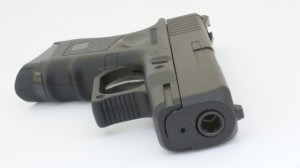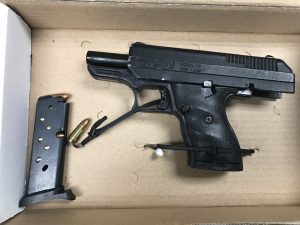 A 26-year-old Washington D.C. man has been charged with attempted 2nd degree murder and related firearms offenses after shooting at police officers during a foot chase. The incident began at an Olney indoor swimming center, when employees called the police to report a suspicious individual on the property. The Maryland National Capital Park Police responded to the scene to investigate, but the suspect had already left the area. Police officers eventually caught up to the suspect’s vehicle, but he fled when police attempted to initiate a traffic stop. Park Police officers declined to initiate a high-speed chase, but continued to canvass the area to locate the suspect’s vehicle. A short time later the suspect’s vehicle was in fact located, though the suspect had fled on foot after his car was involved in an accident. Police found the suspect in a residential neighborhood within minutes, but before they were able to place him into custody, he allegedly fired one shot at officers in pursuit. Thankfully, the bullet struck an empty parked car and nobody was injured. The suspect was then taken into custody and then booked into the Montgomery County Detention Center in Rockville. He was charged with attempted 2nd degree murder, first-degree assault, reckless endangerment, and use of a firearm in a crime of violence for shooting at the officers. Additionally, he was charged with possession of a firearm by a convicted felon and loaded handgun in vehicle, and is being held without bail.
A 26-year-old Washington D.C. man has been charged with attempted 2nd degree murder and related firearms offenses after shooting at police officers during a foot chase. The incident began at an Olney indoor swimming center, when employees called the police to report a suspicious individual on the property. The Maryland National Capital Park Police responded to the scene to investigate, but the suspect had already left the area. Police officers eventually caught up to the suspect’s vehicle, but he fled when police attempted to initiate a traffic stop. Park Police officers declined to initiate a high-speed chase, but continued to canvass the area to locate the suspect’s vehicle. A short time later the suspect’s vehicle was in fact located, though the suspect had fled on foot after his car was involved in an accident. Police found the suspect in a residential neighborhood within minutes, but before they were able to place him into custody, he allegedly fired one shot at officers in pursuit. Thankfully, the bullet struck an empty parked car and nobody was injured. The suspect was then taken into custody and then booked into the Montgomery County Detention Center in Rockville. He was charged with attempted 2nd degree murder, first-degree assault, reckless endangerment, and use of a firearm in a crime of violence for shooting at the officers. Additionally, he was charged with possession of a firearm by a convicted felon and loaded handgun in vehicle, and is being held without bail.
The defendant was already on probation in Montgomery County after he pleaded guilty to robbery almost two years ago. This guilty finding is the reason he was prohibited from possessing a firearm. In that case he was sentenced to 18 months in jail with an additional 6.5 years of suspended time, which will now be on the table when he appears for a violation of probation. This could explain why the defendant was so motivated to avoid being captured by police. In reality, his decision to fire at the police officers will likely far outweigh any possible punishment for the violation of probation. The defendant also has three new additional criminal cases that will also likely take a back seat to the attempted murder. He has two theft and credit card fraud cases out of Montgomery County, as well as an additional armed robbery case from Prince George’s County for an alleged incident that occurred just three weeks ago. It is safe to say that the defendant will be held in the Montgomery County Correctional Facility until a trial or a plea is scheduled, with the only exception being the potential that he is charged in federal court for his actions.
The Blog will continue to follow this case and may post a follow up article in the future. It does not seem likely that this case will end up going to trial, as the evidence of guilt appears to be significant. It may be in the best interest of the defense to attempt to organize some sort of global plea agreement on the shooting case that includes the violation of probation and the new theft charges. A speedy plea agreement may prevent the matter from being picked up by the feds, though the Prince George’s County armed robbery may prove to be an obstacle. The defendant’s guidelines will likely end up being either 7-13 years or 10-15 years on the attempted murder, which all things considered could be much worse. Any plea offer would almost certainly include a charge for felon in possession of a firearm or use of a firearm in a crime of violence. In shooting cases the state typically requires this charge to assure that the first five years of the sentence are served without the possibility of parole. Regardless, the defendant would only be eligible for parole after serving at least 50 percent of the sentence, as the charges of attempted murder and first-degree assault are considered crimes of violence.
 There was significant movement last week in highly publicized state measures to curb the circulation of unserialized firearms commonly known as ghost guns. Both the House and Senate preliminarily approved legislation that would eventually ban the sale and ownership of the untraceable firearms in Maryland. These untraceable guns have been a major point of contention for police and law makers alike, and have undoubtedly contributed to an increased number of gun crimes over the past couple of years. The gun components are often made of polymer or other materials that are easy to fashion yet strong enough to withstand the explosion of a cartridge being fired, and are relatively cheap. Basically, anyone with internet access and a Venmo account could order the components to make a working firearm in a matter of hours. Therefore, it’s no surprise that a state like Maryland that already has some of the toughest gun laws in the country is making serious moves to eliminate untraceable firearms.
There was significant movement last week in highly publicized state measures to curb the circulation of unserialized firearms commonly known as ghost guns. Both the House and Senate preliminarily approved legislation that would eventually ban the sale and ownership of the untraceable firearms in Maryland. These untraceable guns have been a major point of contention for police and law makers alike, and have undoubtedly contributed to an increased number of gun crimes over the past couple of years. The gun components are often made of polymer or other materials that are easy to fashion yet strong enough to withstand the explosion of a cartridge being fired, and are relatively cheap. Basically, anyone with internet access and a Venmo account could order the components to make a working firearm in a matter of hours. Therefore, it’s no surprise that a state like Maryland that already has some of the toughest gun laws in the country is making serious moves to eliminate untraceable firearms.
 There was significant movement last week in highly publicized state measures to curb the circulation of unserialized firearms commonly known as ghost guns. Both the House and Senate preliminarily approved legislation that would eventually ban the sale and ownership of the untraceable firearms in Maryland. These untraceable guns have been a major point of contention for police and law makers alike, and have undoubtedly contributed to an increased number of gun crimes over the past couple of years. The gun components are often made of polymer or other materials that are easy to fashion yet strong enough to withstand the explosion of a cartridge being fired, and are relatively cheap. Basically, anyone with internet access and a Venmo account could order the components to make a working firearm in a matter of hours. Therefore, it’s no surprise that a state like Maryland that already has some of the toughest gun laws in the country is making serious moves to eliminate untraceable firearms.
There was significant movement last week in highly publicized state measures to curb the circulation of unserialized firearms commonly known as ghost guns. Both the House and Senate preliminarily approved legislation that would eventually ban the sale and ownership of the untraceable firearms in Maryland. These untraceable guns have been a major point of contention for police and law makers alike, and have undoubtedly contributed to an increased number of gun crimes over the past couple of years. The gun components are often made of polymer or other materials that are easy to fashion yet strong enough to withstand the explosion of a cartridge being fired, and are relatively cheap. Basically, anyone with internet access and a Venmo account could order the components to make a working firearm in a matter of hours. Therefore, it’s no surprise that a state like Maryland that already has some of the toughest gun laws in the country is making serious moves to eliminate untraceable firearms.
 Criminal Defense Lawyer Blog
Criminal Defense Lawyer Blog










